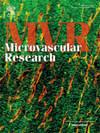PDGF-BB/PDGFR-β信号通路在小鼠实验性蛛网膜下腔出血后微循环紊乱和血脑屏障破坏中的作用
IF 2.7
4区 医学
Q2 PERIPHERAL VASCULAR DISEASE
引用次数: 0
摘要
动脉瘤性蛛网膜下腔出血(aSAH)后的大血管痉挛并不能完全解释延迟性脑缺血(DCI)的机制,越来越多的证据表明微循环功能在DCI中起重要作用。以往关于PDGF- bb及其下游通路的研究多集中于SAH后的大血管痉挛,未关注PDGF通路与微循环的关系。通过添加PDGF-BB和PDGFRβ拮抗剂建立小鼠SAH体外和离体模型,检测PDGFRβ及其下游蛋白的表达,评估干预对aSAH后小鼠神经功能评分、脑水肿和血脑屏障通透性的影响,并通过透射电镜观察模型建立后各组小鼠大脑皮层微血管的状态。SAH后PDGFRβ表达增加,激活下游ERK和AKT通路,而抑制剂伊马替尼抑制了这一作用。伊马替尼可改善SAH后小鼠的神经损伤,减少脑水肿,并显著抑制血脑屏障破坏。在SAH后一周,我们观察到伊马替尼干预减轻了对微循环系统的损伤,并部分保留了微循环的正常功能。伊马替尼通过阻断PDGFR及其下游通路减少SAH后早期血脑屏障破坏,改善微循环功能,从而减轻SAH后的神经功能损害。PDGF-BB-PDGFR -β通路可能在sah后DCI中发挥重要作用。本文章由计算机程序翻译,如有差异,请以英文原文为准。
The role of the PDGF-BB/PDGFR-β signaling pathway in microcirculatory disturbances and BBB destruction after experimental subarachnoid hemorrhage in mice
Large vessel spasm after aneurysmal subarachnoid hemorrhage (aSAH) does not fully explain the mechanism underlying delayed cerebral ischemia (DCI), and increasing evidence suggests that microcirculatory function plays an important role in DCI. Previous studies on PDGF-BB and its downstream pathways have focused mostly on large vessel spasms after SAH, and no attention has been given to the relationship between the PDGF pathway and microcirculation. By establishing in vitro and ex vivo mouse SAH models via the addition of PDGF-BB and PDGFRβ antagonists, the expression of PDGFRβ and its downstream proteins was examined to assess the effects of the intervention on neurological function scores, cerebral edema, and blood–brain barrier permeability in mice after aSAH and to observe the state of the cerebral cortex microvasculature in each group of mice after model establishment using transmission electron microscopy. PDGFRβ expression increased after SAH and activated the downstream ERK and AKT pathways, and the inhibitor imatinib inhibited this effect. Imatinib administration ameliorated neurological impairments, reduced brain edema and significantly inhibited blood–brain barrier disruption in mice after SAH. One week after SAH, we observed that imatinib intervention attenuated damage to the microcirculatory system and partially preserved the normal function of the microcirculation. Imatinib reduced BBB disruption and improved microcirculatory function in the early post-SAH period by blocking PDGFR and its downstream pathway, thereby attenuating neurological impairment after SAH. The PDGF-BB–PDGFR-β pathway may play an important role in post-SAH DCI.
求助全文
通过发布文献求助,成功后即可免费获取论文全文。
去求助
来源期刊

Microvascular research
医学-外周血管病
CiteScore
6.00
自引率
3.20%
发文量
158
审稿时长
43 days
期刊介绍:
Microvascular Research is dedicated to the dissemination of fundamental information related to the microvascular field. Full-length articles presenting the results of original research and brief communications are featured.
Research Areas include:
• Angiogenesis
• Biochemistry
• Bioengineering
• Biomathematics
• Biophysics
• Cancer
• Circulatory homeostasis
• Comparative physiology
• Drug delivery
• Neuropharmacology
• Microvascular pathology
• Rheology
• Tissue Engineering.
 求助内容:
求助内容: 应助结果提醒方式:
应助结果提醒方式:


